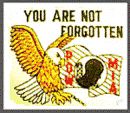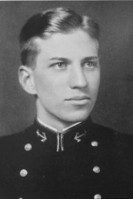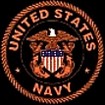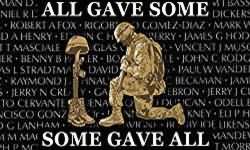CMDR. Porter W. Maxwell
July 24, 1945

Fondly remembered by
family and friends
|

Served Proudly
|
Porter W. Maxwell, CMDR
"Maxie"
1913 – 1945
MAXIE, heeding the adventurous call of the sea, laid aside the jug of cawn, bid the folks and winsome mountain lassies goodbye, and hit the trail for Annapolis. His carefree attitude and utter disregard for the many difficulties which marked this new career soon won him an unlimited host of friends. Naturally energetic, Porter turned to athletics; participating in basketball and lacrosse with more than average success. Maxie's pet avocation is the expounding of his philosophical views on love and life, and we will all agree that he ranks among the best of the sea lawyers. Independent and ambitious; these are the characteristics which predict a bright future for Maxie. Once course and speed are set, life will be smooth sailing for the seagoing mountaineer.
Football 4; Basketball 4, 3, 2, 1. N.A.; Lacrosse 4, 3, 2, 1. N; N Club; Expert Rifleman; Two Stripes
LOSS:
— CMDR. Porter W. Maxwell, Porter was lost when his F6F-5 Hellcat was shot down near Kure, Japan, on July 24, 1945..
He was commanding officer of Bombing Fighting Squadron (VBF) 87 from the decks of USS Ticonderoga (CV 14); he had taken command on January 2, 1945.
From an article on James Vernon, a pilot in Porter's squadron, in the Ventura County Star on August 6, 2008:
Much of the flying that Vernon's group did involved trying to find the bases where kamikaze aircraft were hiding and put them out of commission before they attacked the American fleet.
"Kamikazes killed about 10,000 American sailors," he said. "We tried to find them before they found us."
During one such mission, Vernon was wingman to the squadron leader, Cmdr. Porter Maxwell. They were not facing fighter plane opposition, but there was a great deal of antiaircraft fire from the Kure Naval Base, he said.
Flying south and then east of Hiroshima over Niihama Bay, Vernon said, "the skipper was on my left and all of a sudden, I noticed what looked like debris coming from his tail. It just seemed to fall apart."
Vernon recounts what happened next in his book, "The Hostile Sky":
"The skipper's canopy opened, he stood up, his parachute streamed out and jerked him clear of the plane. The Hellcat hit the water with the skipper a few feet to the right of it. His parachute didn't blossom to check his fall; he plunged feet first into the murky shallow water and disappeared."
His wife was listed as next of kin. Porter is buried and has a separate memory marker in West Virginia.
Remembrances
Commander Porter W. Maxwell, USN, U.S. Naval Academy Class of 1936, was among the last officers to report. He had a reputation as a no-nonsense, stern, and aloof man. That was an understatement.
Commander Maxwell had the needed experience to train this new type of squadron. Maxwell had combat experience in the Solomon Islands flying dive-bombers and had headed a dive-bomber training program in Florida before he had become commanding officer of VB-87 at Wildwood. …
VBF-87 was among the first bombing-fighting squadrons in the Navy. With that distinction came the problem of determining to what extent the Hellcat fighter could play the role of dive-bomber.
Silver Star:
Commander Porter W. Maxwell, United States Navy, was awarded the Silver Star for conspicuous gallantry and intrepidity in connection with military operations against the enemy as Commanding Officer of Fighting Bombing Squadron EIGHTY-SEVEN (VFB-87), embarked in U.S.S. TICONDEROGA (CV-14), in action against the Japanese on 24 July 1945. His gallant actions and dedicated devotion to duty, without regard for his own life, were in keeping with the highest traditions of military service and reflect great credit upon himself and the United States Naval Service
General Orders: Bureau of Naval Personnel Information Bulletin No. 348 (March 1946)
Action Date: July 24, 1945
Service: Navy
Rank: Commander
Company: Fighting Bombing Squadron 87 (VBF-87)
Division: U.S.S. Ticonderoga CV-14
Distinguished Flying Cross:
The President of the United States of America takes pleasure in presenting the Distinguished Flying Cross to Commander [then Lieutenant] Porter W. Maxwell, United States Navy, for extraordinary achievement while participating in aerial flight while piloting a dive bomber in the Solomon Islands area from 3 October to 8 November 1942. Commander Maxwell fought with outstanding skill and released his bombs on enemy surface forces, ground installations and troop concentrations. On 8 October he led his flight in an attack on the Japanese fleet near Guadalcanal and scored direct hits on a heavy cruiser.
General Orders: Bureau of Naval Personnel Information Bulletin No. 333 (December 1944)
Action Date: October 3 - November 8, 1942
Service: Navy
Rank: Commander
Class of 1936:
United States Naval Academy: Porter is a 1936 graduate of The United States Naval Academy,
USNA Virtual Memorial Hall:Porter is one of 39 members of the Class of 1936 on Virtual Memorial Hall |
^ back to top ^
|










